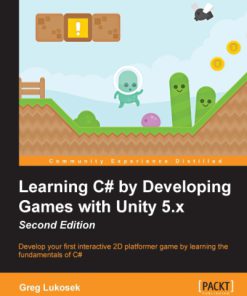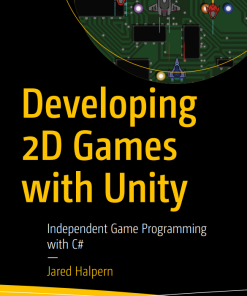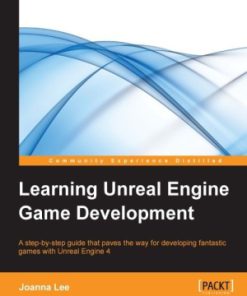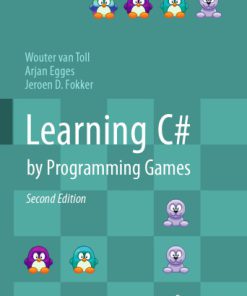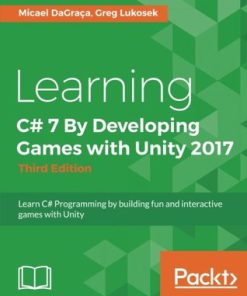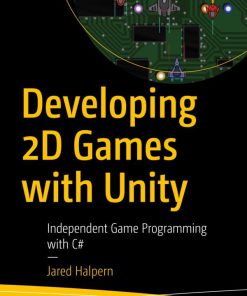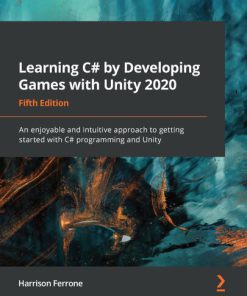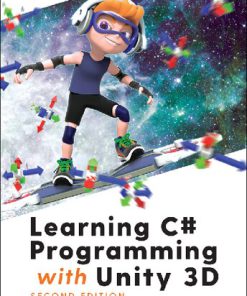Learning C by Developing Games with Unity 5x Develop your first interactive 2D platformer game by learning the fundamentals of C 2nd Edition by Greg Lukosek ISBN 9781785287855 1785287850
$50.00 Original price was: $50.00.$25.00Current price is: $25.00.
Learning C# by Developing Games with Unity 5.x Develop your first interactive 2D platformer game by learning the fundamentals of C# 2nd Edition by Greg Lukosek – Ebook PDF Instant Download/Delivery: 9781785287855 ,1785287850
Full download Learning C# by Developing Games with Unity 5.x Develop your first interactive 2D platformer game by learning the fundamentals of C# 2nd Edition after payment
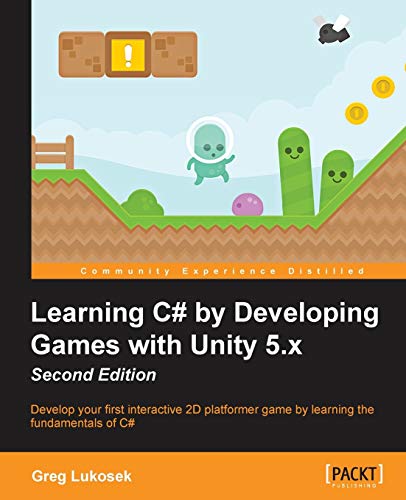
Product details:
ISBN 10: 1785287850
ISBN 13: 9781785287855
Author: Greg Lukosek
Develop your first interactive 2D platformer game by learning the fundamentals of C#
About This Book
- Get to grips with the fundamentals of scripting in C# with Unity
- Create an awesome, 2D platformer game from scratch using the principles of object-oriented programming and coding in C#
- This is a step-by-step guide to learn the fundamentals of C# scripting to develop GameObjects and master the basics of the new UI system in Unity
Who This Book Is For
The book is targeted at beginner level Unity developers with no programming experience. If you are a Unity developer and you wish to learn how to write C# scripts and code by creating games, then this book is for you.
What You Will Learn
- Understand the fundamentals of variables, methods, and code syntax in C#
- Get to know about techniques to turn your game idea into working project
- Use loops and collections efficiently in Unity to reduce the amount of code
- Develop a game using the object-oriented programming principles
- Generate infinite levels for your game
- Create and code a good-looking functional UI system for your game
- Publish and share your game with users
In Detail
Unity is a cross-platform game engine that is used to develop 2D and 3D video games. Unity 5 is the latest version, released in March 2015, and adds a real-time global illumination to the games, and its powerful new features help to improve a game’s efficiency.
This book will get you started with programming behaviors in C# so you can create 2D games in Unity. You will begin by installing Unity and learning about its features, followed by creating a C# script. We will then deal with topics such as unity scripting for you to understand how codes work so you can create and use C# variables and methods. Moving forward, you will find out how to create, store, and retrieve data from collection of objects.
You will also develop an understanding of loops and their use, and you’ll perform object-oriented programming. This will help you to turn your idea into a ready-to-code project and set up a Unity project for production. Finally, you will discover how to create the GameManager class to manage the game play loop, generate game levels, and develop a simple UI for the game.
By the end of this book, you will have mastered the art of applying C# in Unity.
Style and approach
This is a step-by-step guide to developing a game from scratch by applying the fundamentals of C# and Unity scripting.
Learning C# by Developing Games with Unity 5.x Develop your first interactive 2D platformer game by learning the fundamentals of C# 2nd Edition Table of contents:
1. Discovering Your Hidden Scripting Skills and Getting Your Environment Ready
Prerequisite knowledge to use this book
Dealing with scriptphobia
Downloading Unity
Obtaining a free license
Teaching behavior to GameObjects
Using Unity’s documentation
Do I need to know all that?
C# documentation – where to find it? Do I need it at all?
The Unity community – asking others for help
Working with C# script files
Lots of files can create a mess
Why does my Project tab look different?
Creating a C# script file
Introducing the MonoDevelop code editor
Syncing C# files between MonoDevelop and Unity
Opening LearningScript in MonoDevelop
The namespace – highlighted in blue
The class definition – highlighted in green
Watching for possible gotchas while creating script files in Unity
Fixing synchronization if it isn’t working properly
Adding our script to GameObject
Instance? What is it?
Summary
2. Introducing the Building Blocks for Unity Scripts
Understanding what a variable is and what it does
Naming a variable
A variable name is just a substitute for a value
Creating a variable and seeing how it works
Declaration
Assignment
Click on Play!
Changing variables
Watching for a possible gotcha when using public variables
What is a method?
Using the term “method” instead of “function”
Method names are substitutes, too
Introducing the class
Inheritance
The Start(), Update(), and Awake() methods and the execution order
Components that communicate using dot syntax
What’s with the dots?
Making decisions in code
Using the NOT operator to change the condition
Checking many conditions in an if statement
Using else if to make complex decisions
Making decisions based on user input
Paper and pencil are powerful tools
Summary
3. Getting into the Details of Variables
Writing C# statements properly
Understanding component properties in Unity’s Inspector
Variables become component properties
Unity changes script and variable names slightly
Changing a property’s value in the Inspector panel
Displaying public variables in the Inspector panel
Private variables
Naming your variables properly
Beginning variable names with lowercase
Using multiword variable names
Declaring a variable and its type
The most common built-in variable types
Assigning values while declaring a variable
Where you declare a variable is important
Variable scope – determining where a variable can be used
Summary
4. Getting into the Details of Methods
Using methods in a script
Naming methods properly
Beginning method names with an uppercase letter
Using multiword names for a method
Parentheses are part of the method’s name
Defining a method the right way
The minimum requirements for defining a method
Understanding parentheses – why are they there?
Specifying a method’s parameters
How many parameters can a method have?
Returning a value from a method
Returning the value
Example
Summary
5. Lists, Arrays, and Dictionaries
What is an array?
Declaring an array
Storing items in the List
Common operations with Lists
List versus arrays
Retrieving the data from the Array or List
Checking the size
ArrayList
Dictionaries
Accessing values
How do I know what’s inside my Hashtable?
Summary
6. Loops
Introduction to loops
The foreach loop
The for loop
An example
The while loop
while versus for loops
Loops in statements
Modulo
Searching for data inside an array
Breaking the loop
Summary
7. Object, a Container with Variables and Methods
Working with objects is a class act
Few facts
Example
Instantiating an object
Bored yet?
Using methods with objects
Custom constructors
Overloading
Summary
8. Let’s Make a Game! – From Idea to Development
Your first game – avoiding the trap of the never-ending concept
The idea
Game mechanics and core components
Breaking a complex idea into smaller parts
Jake on the mysterious planet – the feature list
Procedural level generation
An animated 2D character
Physics
Mouse and touch controls
Collectables and obstacles
Scoring
UI – the user interface
Target platform and resolution
Target screen resolution
Summary
9. Starting Your First Game
Setting up a new Unity project for our game
Backup
Keeping your project clean
Preparing the player prefab
Rigidbody2D
CircleCollider2D
PlayerController
User input
Jump
Animator
Running
Code
PlayerController.cs
Summary
10. Writing GameManager
Gameplay loops
Singleton class
Starting the game
Setting up input keys
Using triggers
Restarting the game
Setting up the player starting position
Code in this chapter
Summary
11. The Game Level
Generating levels versus designed levels
Creating a level chunk
Planning the LevelGenerator class
Writing LevelGenerator
Commenting on your code
Creating a copy of the level piece
Instantiating
Vector3
Testing LevelGenerator
Extending the level
The code used in this chapter
Summary
12. The User Interface
Introducting the Unity UI
Views
Constructing the view UI – how to keep things clean
Target screen resolution
Recognizing events
Buttons
A simple button
Image
The Button component
Interaction
The Button action
Hiding and showing the Canvas
Reference exceptions
GameView
Game Over
The code in this chapter
Summary
13. Collectables — What Next?
Collectables
The coin prefab
The Collectable class
High score and persisting data
The Update function and UI values
What next?
The code in this chapter
Summary
Index
People also search for Learning C# by Developing Games with Unity 5.x Develop your first interactive 2D platformer game by learning the fundamentals of C# 2nd Edition:
learning c# for unity 2d
learning unity game engine
unity learning curve
learning c# by developing games with unity 5.x
Tags:
Greg Lukosek,Learning C,Developing Games,Unity 5x,interactive,platformer,fundamentals
You may also like…
Computers - Programming
Computers - Programming
Developing 2D Games with Unity: Independent Game Programming with C# 1st Edition Jared Halpern
Computers - Programming
Computers - Programming
Computers - Programming
Computers - Programming
Developing 2D Games with Unity: Independent Game Programming with C# 1st Edition Jared Halpern
Computers - Programming
Computers - Programming
Computers - Programming




